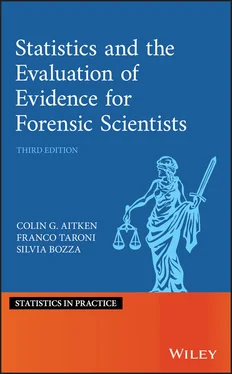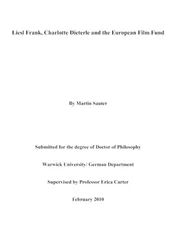It is sometimes useful to refer to material found at the scene of a crime as the crime scene item and to material found on or about a PoI as the suspect item . This terminology reflects the site at which the material was found. It does not indicate the kind of material (bulk or transferred particle form) or the perspective (scene – or suspect – anchored) by which the evidence will be evaluated.
A generic name for observations that are made on items of interest, such as bloodstains, refractive indices of glass, etc. is data . There are different types of data and some terminology is required to differentiate amongst them. For example, consider shoe types. The observations of interest are the shoe types as observable on surveillance camera recordings and those observable in possession of a PoI. These shoe types are not quantifiable. There is no numerical significance that may be attached to these. The shoe type is a qualitative characteristic. As such, it is an example of so‐called qualitative data , sometimes known as categorical data . The observation of interest is a quality, the shoe type, which has no numerical significance. The different shoe types are sometime known as categories . The assignation of a shoe to a particular category is called a classification . A shoe may be said to be assigned to one of several categories (see the discussion on the definition of identification in Section 2.5.9). Other examples of categorical data include types of firearms and makes of cars.
It is not possible to order shoe types and say that one type is larger or smaller than another. However, there are other qualitative data that do have a natural ordering, such as the level of burns on a body. There is not a numerical measure of this but the level of burns may be classified as first, second, third degree, for example. Qualitative data that have no natural ordering are known as nominal data. Qualitative data to which a natural ordering may be attached are known as ordinal data. An ordinal characteristic is one in which there is an underlying order even though it is not quantifiable. Pain is another such characteristic; level of trauma may be ordered as none, slight, mild, severe, or very severe. The simplest case of nominal data arises when an observation may be classified into one of only two possible categories. For example, consider the magnetism of toner present on printed documents. Some toners are magnetic, whereas others are not. Such data are known as binary . Alternatively, the variable of interest, here magnetism, is known as dichotomous ; it is either present or absent (Biedermann et al. 2016c).
Other types of data are known as quantitative data. These may be either counts (known as discrete data, since the counts take discrete, integer, values) or measurements (known as continuous data, since the measurements may take any value on a continuous interval).
A violent crime involving several people, victims and offenders, may result in much blood being spilt and many stains from each of several DNA profiles being identified. Then the numbers of stains for each of the different profiles are examples of discrete, quantitative data. Other examples of discrete quantitative data are the number of glass fragments found on a PoI, or the number of gunshot residue particles on hands.
The refractive indices and elemental concentrations of glass fragments are examples of continuous measurements. In practice, variables are rarely truly continuous because of the limits imposed by the sensitivity of the measuring instruments. For example, refractive indices may be measured only to a certain number of decimal places.
Observations, or data, may thus be classified as qualitative or quantitative. Qualitative data may be classified further as nominal or ordinal, and quantitative data may be classified further as discrete or continuous.
‘Who is “random man”?’ This is the title of a paper by Buckleton et al. (1991). In order to evaluate evidence, it is necessary to have some idea of the variability or distribution of the evidence under consideration within some population. This population will be called the relevant population (and a more formal definition will be given later in Section 6.1.1) because it is the population that is deemed relevant to the evaluation of the evidence. Variability is important because if the PoI did not commit the crime and is, therefore, assumed innocent it is necessary to be able to determine the probability of associating the evidence with them when they are innocent. Surveys of populations are required in order to obtain this information. Surveys for reference data are regularly published in forensic science or legal medicine journals (e.g. Forensic Science International , Science & Justice , Journal of Forensic Sciences , International Journal of Legal Medicine ); they are widely available to the scientific community.
Care has to be taken when deciding how to choose the relevant population. Buckleton et al. (1991) describe two situations and explain how the relevant population is different for each.
The first situation is one in which there is transfer from the criminal to the crime scene as in Example 1.1 and discussed in greater detail in Section 5.3.1.4. In this situation, the details of any PoI are irrelevant under  , the proposition that the PoI was not present at the scene of the crime. Consider a bloodstain at the crime scene that, from the background information
, the proposition that the PoI was not present at the scene of the crime. Consider a bloodstain at the crime scene that, from the background information  , it is possible to assume is of blood from the criminal. If the PoI was not present, then clearly some other person must have left the stain. There is no reason to confine attention to any one group of people. In particular, attention should not be confined only to any group (e.g. ethnic group) to which the PoI belongs. However, if there is some information that might cause one to reconsider the choice of population, then that choice may be modified. Such information may come from an eyewitness, for example, who is able to provide information about the offender's ethnicity. This would then be part of the background information
, it is possible to assume is of blood from the criminal. If the PoI was not present, then clearly some other person must have left the stain. There is no reason to confine attention to any one group of people. In particular, attention should not be confined only to any group (e.g. ethnic group) to which the PoI belongs. However, if there is some information that might cause one to reconsider the choice of population, then that choice may be modified. Such information may come from an eyewitness, for example, who is able to provide information about the offender's ethnicity. This would then be part of the background information  . Further comments on the role of background information
. Further comments on the role of background information  may be found in Section 2.4.4. In general, though, information about DNA profile frequencies would be required from a survey, which is representative of all possible offenders. For evidence of DNA profiles, it is known that age is not a factor affecting a person's profile but that ethnicity is. It is necessary to consider the racial composition of the population of possible offenders (not persons of interest). Normally, it is necessary to study a general population since there will be no information available to restrict the population of possible criminals to any particular ethnic group or groups.
may be found in Section 2.4.4. In general, though, information about DNA profile frequencies would be required from a survey, which is representative of all possible offenders. For evidence of DNA profiles, it is known that age is not a factor affecting a person's profile but that ethnicity is. It is necessary to consider the racial composition of the population of possible offenders (not persons of interest). Normally, it is necessary to study a general population since there will be no information available to restrict the population of possible criminals to any particular ethnic group or groups.
The second situation considered by Buckleton et al. (1991) is possible transfer from the crime scene to the PoI or criminal and discussed further in Section 5.3.2.4. The details of the PoI are now relevant even assuming they were not present at the crime scene. Consider the situation where there is a deceased victim who has been stabbed numerous times. A PoI, with a history of violence, has been apprehended with a heavy bloodstain on their jacket that is not of their own blood. What is the evidential value in itself, and not considering possible DNA evidence, of the existence of such a heavy bloodstain, not of the blood of the PoI? The probability of such an event (the existence of a heavy bloodstain) if the PoI did not commit the crime needs to be considered.
Читать дальше

 , the proposition that the PoI was not present at the scene of the crime. Consider a bloodstain at the crime scene that, from the background information
, the proposition that the PoI was not present at the scene of the crime. Consider a bloodstain at the crime scene that, from the background information  , it is possible to assume is of blood from the criminal. If the PoI was not present, then clearly some other person must have left the stain. There is no reason to confine attention to any one group of people. In particular, attention should not be confined only to any group (e.g. ethnic group) to which the PoI belongs. However, if there is some information that might cause one to reconsider the choice of population, then that choice may be modified. Such information may come from an eyewitness, for example, who is able to provide information about the offender's ethnicity. This would then be part of the background information
, it is possible to assume is of blood from the criminal. If the PoI was not present, then clearly some other person must have left the stain. There is no reason to confine attention to any one group of people. In particular, attention should not be confined only to any group (e.g. ethnic group) to which the PoI belongs. However, if there is some information that might cause one to reconsider the choice of population, then that choice may be modified. Such information may come from an eyewitness, for example, who is able to provide information about the offender's ethnicity. This would then be part of the background information  . Further comments on the role of background information
. Further comments on the role of background information  may be found in Section 2.4.4. In general, though, information about DNA profile frequencies would be required from a survey, which is representative of all possible offenders. For evidence of DNA profiles, it is known that age is not a factor affecting a person's profile but that ethnicity is. It is necessary to consider the racial composition of the population of possible offenders (not persons of interest). Normally, it is necessary to study a general population since there will be no information available to restrict the population of possible criminals to any particular ethnic group or groups.
may be found in Section 2.4.4. In general, though, information about DNA profile frequencies would be required from a survey, which is representative of all possible offenders. For evidence of DNA profiles, it is known that age is not a factor affecting a person's profile but that ethnicity is. It is necessary to consider the racial composition of the population of possible offenders (not persons of interest). Normally, it is necessary to study a general population since there will be no information available to restrict the population of possible criminals to any particular ethnic group or groups.










